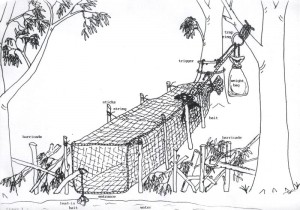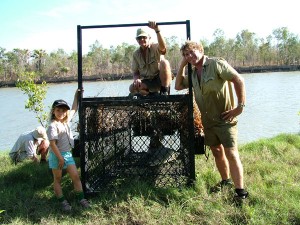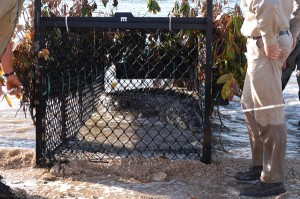Gone are the days when the primary way to capture a crocodile was simply to “jump it” as it swam, as Steve did that first glorious time at age nine.
Source: Chelsea House Pub
Since then, specially designed traps have become the key to a successful crocodile catch, and setting them up is a project in itself. As Steve explained on the official crocodile Hunter Web Site, there are three distinct types of traps used today and each has a distinct method of use.
Soft mesh traps
Source: crocodilehunter.com.au
The Irwins developed this original trapping technique, the only one Steve used until the 1990s. The mesh trap is usually set up on a sloping bank, secured along the sides with sticks driven into the mud, and kept in place with a rope secured by a steel ring to a sturdy tree. The trapping mechanism is a drawstring, created by weaving the rope through the mesh at the opening of the trap, which quickly pulls closed when the trap is triggered. The trigger involves suspending several weighted bags (filled with sand or dirt) attached to a piece of bait, such as a piece of feral pig (wild boar). The trapper decides how high and wide to make the trap, based on an estimate of the animal’s size, which he or she can determine by looking for “slides,” or crocodile tracks in the mud.
Gate traps
Gate traps are a variation of the classic soft mesh trap. The main difference is that this trap uses a metal gate instead of weights and a drawstring. Although setup takes only about half the time that soft mesh setup takes, Steve noted, “The downside is the clumsiness and bulkiness of the gate in the boat and through the mangrove mud.” The best place for a gate trap is a solid, hard-packed rived bank, where there is no chance of the gate sinking.
Source: crocodilehunter.com.au
Floating traps
Steve engineered his first model of this innovative trap design in 2000. After some modification over the next few years, floating traps became, “unbelievably successful,” he wrote. “They’ve never missed, never failed and constantly [amaze] us with their record breaking success.” As their name implies, these traps made of lightweight aluminium and stainless steel, simply float on the water. The trapper uses a boat to tow the trap to a desired location, and crocodiles literally swim right in to get the bait. A gate closes, and the trapper’s got a crocodile. Benefits to this newer design, according to Steve, include no need for land access and the fact that the crocodile stays submerged even when caught, thus reducing its stress.
Source: crocodilehunter.com.au
The following clip from My Daddy the Crocodile Hunter shows how Steve and his team catch crocodiles using traps, ropes and body weight.




